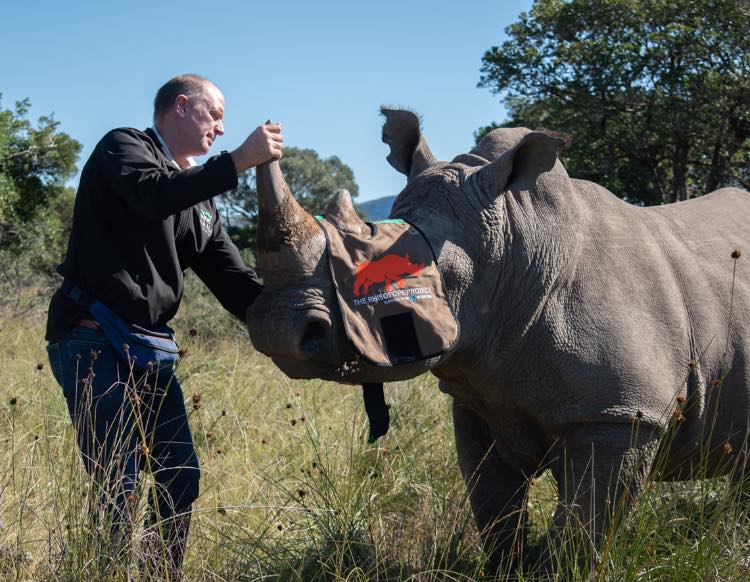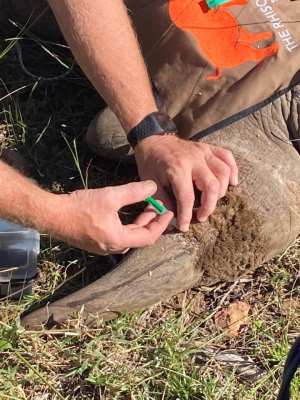
There is no question that poaching has become an existential threat to the five species of rhinoceros alive today. Even the wildlife reserves where most rhinos live struggle to provide protection from the wanton and cruel poaching of the world’s last remaining rhinos.
Poachers are generally looking to sell the horns which consist of pure keratin, the same material that makes up our fingernails and hair. Rhino horns have seen a big rise in demand the past decades, with a black market in Vietnam representing the biggest buyers, primarily for use in fever and other medicines, as well as for processing into carved trinkets. This has contributed to a further rhino population collapse. Statistics from 2017 show about 18,000 white rhinos and fewer than 5,500 black rhinos remaining. Recently, the northern white rhino population in Africa went effectively extinct with the death of the last known male individual.
Clearly, if we wish to prevent extinction, we need to deal with poaching. The latest suggestion here is part of the Rhisotope project. This would make rhino horns radioactive, but how exactly would doing so prevent poaching? Let’s take a look.
Preventing Poaching

The act of poaching is defined as ‘the illegal hunting or capturing of wild animals’. In modern day this mostly refers to the illegal killing of endangered species. The driving force behind much of the poaching in African rural areas is that of poverty. With a kilogram of rhino horn valued at around $60,000 on the black market, even if the poacher gets only a fraction of this from a roughly three kilogram horn, it’s still a highly profitable risk to take despite the increasing security in wildlife reserves.
These high stakes have led to an escalating war between well-armed poachers and security forces, tragically leading to deaths on both sides. Poachers who are brought to justice face prison sentences of up to 25 years. An attempt to reduce the demand in 2013 by literally poison rhino horns to make consuming them dangerous was ultimately cancelled. So far, de-horning rhinos without harming them has been the most effective poached deterrent.
Yet obviously removing the horn from every rhino is not an ideal approach, as they do use their horns for marking their territory and in courtship. Ideally rhinos could keep their horns while also making them unsuitable or impossible to get for buyers in the black market. This is where the Rhisotope project comes into play. Not only will it make the horns easy to track using existing radiation detectors at airports and harbors around the globe, it should not affect the animals themselves.
The Rhisotope Project
In a collaboration between by the University of the Witwatersrand in Johannesburg (WITS), Russian nuclear energy corporation Rosatom, Australian Nuclear Science and Technology Organisation (ANSTO), and Colorado State University (CSU) along with international scientists, the Rhisotope project has a number of goals:
- Demand reduction and horn devaluation
- Education
- Community social uplift and investment
- Research on rhinos
Despite rhinos having been around longer than humans by a few million years, we still know precious little about these last remnants of Earth’s mega fauna. In order to better protect these animals, scientists from WITS, CSU, and other universities are seeking to learn more about rhino physiology. This will also help the education goal, which seeks to make it easy for teachers and others to incorporate educational programs that teach younger generations about why we need to protect rhinos from extinction.
As a largely poverty-driven problem, fixing the poverty problem should go a long way to reducing the willingness of the local population to poach. To illustrate the scale here, if say a local farmer were to assist in the poaching of a rhino, they might get 10,000 South African Rand for it, which converts to roughly $726 USD. Not a lot, one might think, but for the truly poor, this could mean the difference between slow starvation and living like a king for years.
This then leaves the proverbial elephant in the room, with the first point about horn devaluation. While local poachers are part of the problem, there is an international network of crime organizations and black market trading that involves not only rhino horns and elephant tusks, but also other illegal and highly profitable goods. The idea is to make rhino horns unattractive for these organizations, thus reducing demand.
This is where the radioactive isotopes come into play.
From Criminal to Terrorist

As detailed on the Rhisotope project Facebook page, the first steps towards injecting radioactive isotopes (radioisotopes) into rhino horns have commenced, with the injection with first stable isotopes. The goal of this is to see how these materials behave when in the horn.
As a research project, it brings together the expertise and know-how from both wildlife experts and experts on radioisotopes to answer a few basic questions:
- How stable is any isotope in a rhino horn?
- Which radioisotope might be most suitable?
- How can it scale from a handful of rhinos to tens of thousands?
The radiation from these would not be enough to cause any harm to the animal. But smuggling the horn through illicit channels becomes immensely more difficult as the tell-tale radioactive signature would be hard to hide.
Presumably the radioisotope that would be picked would be a Gamma or Beta emitter, as these are significantly harder to block than Alpha (large helium atoms) radiation. This radiation would make the horn, and any shipping container it would be placed into, light up light a Christmas tree on any of the radiation detectors used at borders and ports around the world.
Essentially this would make smuggling these radioactive horns as appealing as smuggling enriched uranium or plutonium through checkpoints. Checks for radioactive material has become much more intense since the 2001 terrorist attack in the US as detailed in this PDF document from 2002 by Interpol, Europol and the IAEA on the detection of radioactive material at borders.
No Simple Solution
Solving the problem of poaching is not easy. While the multiple targets of the Rhisotope projects should give it a pretty good shot at fixing a lot of the problems at hand, ultimately we’re talking about tackling both poverty and international criminal organizations. Neither of these are problems that are new, let alone easy to solve.
Perhaps the idea of strapping the radioisotope equivalent of a GPS tracker to every single rhino horn will make smuggling them unattractive. But it’s something that is incredibly hard to predict.
The demand for horns seems to be increasing. When The Conversation asked people in Vietnam about buying and using rhino horn-based products, it was quite clear that current approaches to deter people from buying these products aren’t effective. In general, the buyers did not care about the plight of rhinos, nor did they buy into the fact that consuming rhino horn is as medicinal as gnawing on your own fingernails. To them, the luxury status and general benefit of these products are larger than those facts.
Time is Running Out
Perhaps the most tragic aspect of the Rhisotope project is that it may be our last attempt at saving these animals from extinction. With experts predicting a whole-scale African rhino population collapse within a decade, this is not an issue where we can check back in a couple of years to see whether things have gotten better. This means not only dealing with poaching, but also finding ways in which human and other animal populations can peacefully co-exist.
Rhinos find themselves running out of habitat, and threatened by poachers as well as trophy hunters. It might only be a matter of years before we find ourselves saying not only farewell to the last rhino, but also the last African elephant, the last giraffe, and many other iconic animals.
For today’s generations, this might be the moment where one has to think about what to tell one’s children and grand-children when asked why we let all of these animals go extinct. We may have years, maybe decades at most, but looking at the plummeting population numbers there can be no mistake that extinction is inevitable for these species unless we act today.
(Heading image: Dr. William Fowlds comforting a rhino as part of the Rhisotope project. Credit: Rhisotope project)
0 Commentaires